Atlanta frontieri
Roger R. SeapyIntroduction
Atlanta frontieri is a moderately large species (shell diameter to 5.5 mm) that is immediately distinguished by an elevated spiral ridge located at the outer edge of the second to fourth spire whorls. The spire consists of 4-1/4 to 4-1/2 whorls. The shape of the spire is unusual; the third and fourth whorls are very low, while the first two whorls form a raised cap. The keel is tall and rounded, inserting between the penultimate and final whorls in shells larger than about 2 mm. Eyes type b. Operculum type b. Radula type II, with the number of tooth rows (44-50) the lowest in the genus Atlanta and moderate sexual dimorphism in the marginal teeth. Recorded from the Indian Ocean and western North Pacific Ocean; vertical distribution unknown.
Diagnosis
- Shell diameter to 5.5 mm
- Shell spire of 4-1/4 to 4-1/2 whorls
- Third and fourth whorls of spire low, while first and second whorls form a raised cap
- Distinctive elevated spiral ridge located on outer edge of the second to most of the fourth spire whorls
- Keel tall and rounded; inserting between penultimate and final shell whorls in shells larger than about 2 mm
- Eyes type b
- Operculum type b
- Radula type II, with low number of tooth rows (44-50) and moderate sexual dimorphism in the marginal teeth
Characteristics
- Shell
- Shell moderately large (to 5.5 mm diameter)
- Shell transparent
- Spire consists of 4-1/4 to 4-1/2 whorls
- Thin spiral ridge along the outer margin of the spire whorls beginning on the second and ending at about 3-3/4 whorls (see second SEM below). Height of spiral ridge to about 20 µm on the second and third whorls (Richter, 1993)
- Spire shape low with first and second whorls elevated, forming a low cone (see third and fourth SEMs below)
 Click on an image to view larger version & data in a new window
Click on an image to view larger version & data in a new window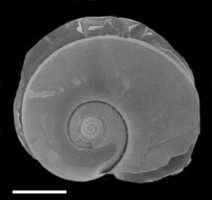
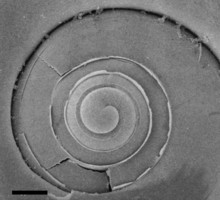
Figure. Scanning electron micrographs of the shell of Atlanta frontieri, viewed from the right side (left; scale bar = 0.5 mm) and the spire (right; scale bar = 100 µm). © Roger R. Seapy
 Click on an image to view larger version & data in a new window
Click on an image to view larger version & data in a new window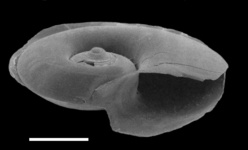
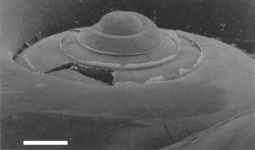
 Click on an image to view larger version & data in a new window
Click on an image to view larger version & data in a new windowFigure. Scanning electron micrographs of the right side of an Atlanta frontieri shell in tilted views; shell (left; scale bar = 0.5 mm) and spire region (right; scale bar = 100 µm). ©
- Larval shell with the elevated spiral ridges on outer sides of second to fourth whorls (see SEMs and the shell sketch below)
- Keel moderately tall and rounded, inserting between the fourth and fifth whorls in animals larger than about 2 mm (see title illustration)
- Eyes type b
- Operculum type b
- Radula type II
- Number of tooth rows limited to 44-50; lowest in the genus Atlanta (Richter, 1993)
- The lateral teeth are higher and thicker laterally than in the other two species (A. rosea and A. fragilis) in the A. peronii species group studied by Richter (1993)
- Moderate sexual dimorphism in the size and shape of the marginal teeth (see male and female radula SEMs below). The marginal teeth are somewhat longer and the tooth shafts more curved in female radulae
 Click on an image to view larger version & data in a new window
Click on an image to view larger version & data in a new window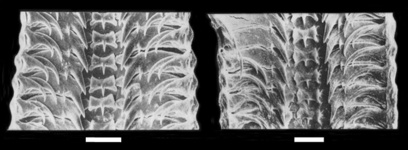
Figure. Portions of the male (left) and female (female) radulae in Atlanta frontieri. Note that in each tooth row, a lateral tooth is located on each side of the central tooth. Scale bars = 25 µm. Original photographs from Richter (1993, fig. 21), modified by addition of scale bars. © 1993 G. Richter
Comments
Tokioka (1955) was the first author to illustrate Atlanta frontieri in an apertural view of the larval shell (see Tokioka's drawing above); erroneously identifying the shell as belonging to A. inflata. In 1966 Frontier briefly described and illustrated the same species as A. peronii. In his monograph on the Heteropoda of the Indian Ocean, Richter (1974) followed Frontier's (1966) lead and incorrectly characterized the species at hand as A. peronii. Nineteen years later, Richter (1993) corrected his misidentification from 1974 and described A. frontieri as a new species. In this paper he also reported that the new species shared a series of characters (notably the same eye, opercular and radular types) with A. peronii and the other two members (A. rosea and A. fragilis) of the A. peronii species group.
Atlanta frontieri has been recorded from the western North Pacific by Tokioka (1955; see above), although the species has not been reported from Hawaiian waters (Seapy, 1990) or off the U. S. west coast (Seapy, pers. obs.). Also, Newman (1990) did not record it from eastern Australian or New Guinean waters. The majority of records of the species are from the northern Indian Ocean, where Richter (1974) recorded it as the sixth most abundant atlantid species in his samples. Seapy et al. (2003) also reported it from the southeastern Indian Ocean. Thus, A. frontieri must be regarded as an Indo-Pacific species. The vertical distribution of A. frontieri has not been investigated.
References
Frontier, S. 1966. Notes morphologiques sur les Atlanta récoltées dans le plancton de Nosy Bé (Madagascar). Cahiers ORSTOM, Série Océanographie 4: 131-139.
Richter, G. 1974. Die Heteropoden der "Meteor"-Expedition in den Indischen Ozean, 1964/65. "Meteor" Forschungs-Ergebnisse (D) 17: 55-78.
Richter, G. 1993. Zur Kenntnis der Gattung Atlanta (V). Die Atlanta peroni-Gruppe und Atlanta gaudichaudi (Prosobranchia: Heteropoda). Archiv für Molluskenkunde 122: 189-205.
Seapy, R. R. 1990. The pelagic family Atlantidae (Gastropoda: Heteropoda) from Hawaiian waters: a taxonomic survey. Malacologia 32: 107-130.
Seapy, R. R., C. M. Lalli and F. E. Wells. 2003. Heteropoda from western Australian waters, pp. 513-546. In: F. E. Wells, D. I. Walker and D. S. Jones (eds.), The Marine Flora and Fauna of Dampier, Western Australia. Western Australia Museum, Perth.
Tokioka, T. 1955. On some plankton animals collected by the Syunkotu-Maru in May-June 1954. II. Shells of Atlantidae (Heteropoda). Publications of the Seto Marine Biological Laboratory 4: 227-235.
About This Page

California State University, Fullerton, California, USA
Correspondence regarding this page should be directed to Roger R. Seapy at
Page copyright © 2011
 Page: Tree of Life
Atlanta frontieri .
Authored by
Roger R. Seapy.
The TEXT of this page is licensed under the
Creative Commons Attribution License - Version 3.0. Note that images and other media
featured on this page are each governed by their own license, and they may or may not be available
for reuse. Click on an image or a media link to access the media data window, which provides the
relevant licensing information. For the general terms and conditions of ToL material reuse and
redistribution, please see the Tree of Life Copyright
Policies.
Page: Tree of Life
Atlanta frontieri .
Authored by
Roger R. Seapy.
The TEXT of this page is licensed under the
Creative Commons Attribution License - Version 3.0. Note that images and other media
featured on this page are each governed by their own license, and they may or may not be available
for reuse. Click on an image or a media link to access the media data window, which provides the
relevant licensing information. For the general terms and conditions of ToL material reuse and
redistribution, please see the Tree of Life Copyright
Policies.
- First online 31 January 2010
- Content changed 23 July 2011
Citing this page:
Seapy, Roger R. 2011. Atlanta frontieri . Version 23 July 2011 (under construction). http://tolweb.org/Atlanta_frontieri/28758/2011.07.23 in The Tree of Life Web Project, http://tolweb.org/




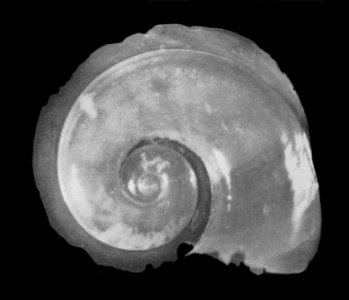
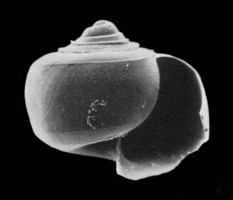
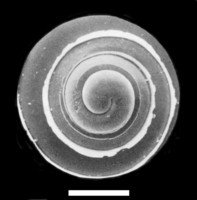
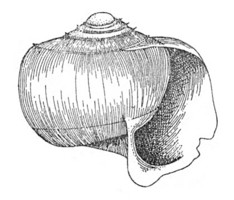
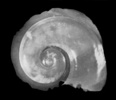


 Go to quick links
Go to quick search
Go to navigation for this section of the ToL site
Go to detailed links for the ToL site
Go to quick links
Go to quick search
Go to navigation for this section of the ToL site
Go to detailed links for the ToL site